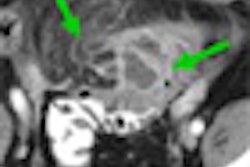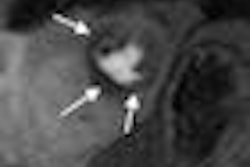Using computer-aided detection (CAD) software with a 3D display technique can increase sensitivity for inexperienced readers of virtual colonoscopy exams, but it fails to narrow the performance gap with experienced interpreters, according to a study published in the October issue of Clinical Radiology.
In addition, the Swedish research team found that the sensitivity improvement came at the cost of lower specificity in reading virtual colonoscopy (also known as CT colonography or CTC) studies. As a result, the authors stressed the importance of training inexperienced readers in lesion characterization (Clin Radiol, October 2009, Vol. 64:10, pp. 972-982).
The research group, led by Dr. Valeria Fisichella of Sahlgrenska University Hospital and Sahlgrenska Academy at the University of Gothenburg in Gothenburg, Sweden, sought to evaluate the use of CAD as a second reader with a new 3D display method called perspective-filet view, or 3D filet view.
This display mode, a variant of virtual dissection software, involves unrolling the colon to allow for 420° visualization. It also angles the projection rays, allowing for both sides of colonic folds to be shown during unidirectional viewing, according to the authors.
The method was tested in a prospective evaluation of 50 symptomatic patients receiving CTC and same-day colonoscopy between October 2006 and May 2007. In the first part of the research project, an experienced reader (who had read more than 200 CTC studies) used CAD as a second reader after a complete 3D and 2D CTC reading protocol, immediately prior to the colonoscopy.
With this approach, the researchers sought to optimize the performance of the colonoscopy exams, allowing for CAD marks accepted by the reader to be prospectively evaluated at colonoscopy, Fisichella said.
"Performing a careful prospective analysis with 3D, 2D, and CAD would maximize the detection of lesions at CTC," she told AuntMinnie.com. "This was useful in order to see how many lesions are missed at first-look colonoscopy, and in order to optimize the reference standard [CTC + colonoscopy]."
In the second phase of the study, the researchers evaluated how CAD affects the performance of inexperienced readers. With that goal in mind, two readers first evaluated the studies with a 3D reading session, and then, months later, they utilized CAD as a second reader to look for missed lesions, according to Fisichella.
Using an Extended Brilliance 3.0.1 dedicated workstation (Philips Healthcare, Andover, MA) with Perspective Filet View CTC software, the studies were read by the experienced reader (reader 1) using a primary 3D filet analysis (with 3D endo-fly-through or 2D viewing available for problem-solving), followed by a complete 2D analysis.
Once this review was completed, Colon CAD software (Philips) was applied; CAD marks that did not coincide with findings on the 3D filet and 2D analysis were evaluated on the 3D filet view, with 3D endo-fly-through or 2D again used to resolve any issues.
The studies were later reviewed separately by two inexperienced CTC readers, who were blinded to the colonoscopy and CTC findings. The first inexperienced reader (reader 2) had attended a hands-on course on CTC and had previously reviewed 30 CTC cases with dedicated software different from the application employed in the study, according to the study team.
The other inexperienced reader (reader 3) had received course material and CTC review articles to learn the theoretical basics of CTC interpretation, according to the authors. Both readers also received training by viewing 15 proven CTC exams on the workstation used in the study.
The inexperienced readers reviewed the cases first via the same primary 3D filet analysis performed by the experienced reader. Five weeks later, they reviewed the studies with a primary 2D analysis, with 3D endo-fly-through or 3D filet available to solve problems.
Four months after the 2D analysis, the inexperienced readers blindly read the studies again, this time with access to CAD. They checked whether the CAD marks matched their own previous findings; marks that did not match were further evaluated on 3D filet view, with 3D endo-fly-through and 2D views available for problem-solving.
To evaluate CAD's performance, color marks were compared with the reference standard of findings at colonoscopy. Due to the CAD minimum filter size setting of 3 mm, only lesions 3 mm or larger detected on colonoscopy were included in the analysis. The performance of the inexperienced readers by mode was evaluated using jackknife free-response receiver operator characteristics (JAFROC-1) analysis.
There were 103 lesions detected in 34 patients at colonoscopy with segmental unblinding; 16 were ≥ 10 mm, 19 were 6-9 mm, and 68 were 3-5 mm in size. Evaluated on its own, CAD turned in prelesion sensitivity of 89% for lesions ≥ 6 mm and 73% for lesions ≥ 3 mm.
CAD also detected all three cancers. The researchers found a mean number of 12.8 false-positive CAD marks per patient in the supine position and 11.4 false positives in the prone position.
Relying on the 3D filet view and 2D analysis, the experienced reader had a sensitivity of 83% (29/35) for lesions ≥ 6 mm in size (with a false-positive rate of 0.40) and 66% (68/103) for lesions ≥ 3 mm (false-positive rate of 1.54). With the help of CAD, the reader was able to correctly identify one additional medium-sized polyp and four additional small polyps, increasing sensitivity to 86% for medium-sized lesions (with a false-positive rate of 0.44) and 71% for small lesions (false-positive rate of 1.60).
Per-lesion sensitivity among three VC readers
|
||||||||||||||||||||||||||||
Regarding the inexperienced readers, reader 2 had a sensitivity of 57% for lesions ≥ 6 mm and 44% for lesions ≥ 3 mm with just the 2D analysis. Reader 3 had 43% sensitivity for lesions ≥ 6 mm and 32% for lesions ≥ 3 mm using only 2D analysis.
Reader 3, the least inexperienced reader, realized a statistically significant sensitivity gain with 3D filet and CAD compared with 3D filet alone for medium-sized lesions (p < 0.05). For small lesions (≥ 3 mm), both readers recorded statistically significant increases in sensitivity with 3D filet and CAD compared with 3D filet and 2D (p < 0.05).
The FROC curves showed that at a constant diagnostic confidence level, the inexperienced readers using the combination of 3D filet and CAD saw an increase in per-lesion sensitivity for lesions ≥ 3 and ≥ 6 mm -- but also higher false-positive rates -- compared with 3D filet alone, the researchers determined.
Furthermore, 3D filet and CAD combined had higher sensitivity, but also a higher false-positive rate, when compared with 2D. The one exception was reader 2 in lesions ≥ 6 mm, where sensitivity with 3D filet and CAD was the same as with 2D, but with a higher false-positive rate, the researchers noted.
"Applied as a second reader using perspective filet view (3D filet + CAD), [CAD] increased the sensitivity of the inexperienced readers compared with 3D filet and 2D, although it did not improve the overall performance as the number of [false-positive] findings also increased," the authors wrote. "Furthermore, the sensitivity of inexperienced readers for lesions ≥ 6 mm with 3D filet + CAD did not reach the level of an experienced reader using 3D filet. CAD seems to improve lesion perception in inexperienced readers, but training on characterization of lesions remains vital."
By Erik L. Ridley
AuntMinnie.com staff writer
September 30, 2009
Related Reading
Flat-polyp measurements show less variability in 3D VC, September 16, 2009
Virtual colonoscopy CAD improves flat-lesion detection, June 5, 2009
VC's high positive predictive value important for colonoscopy follow-up, April 30, 2009
Minimal-prep VC may miss more flat lesions, April 17, 2008
Flat colorectal tumors relatively common in U.S. population, linked to cancer, March 5, 2007
Copyright © 2009 AuntMinnie.com



















